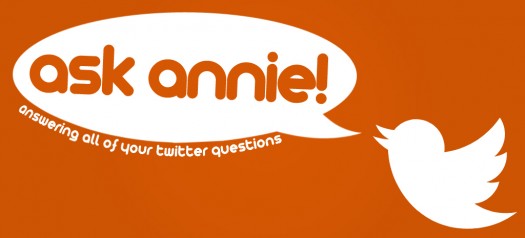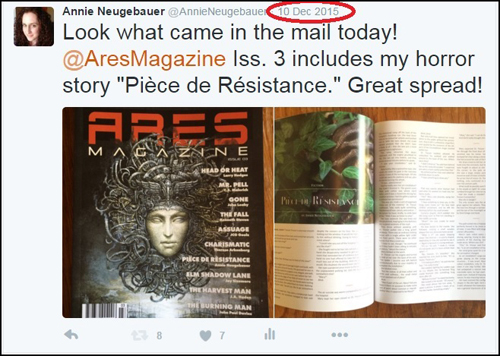Ask Annie: How Long Does a Tweet Live?
By Annie Neugebauer | January 9, 2016 |

How long does a tweet live before it gets buried in the scroll line? Someone told me less than 60 seconds. Is that accurate? –Paula Cappa, @PaulaCappa1
I like this question because I see more implied here than is stated. On the lines, I read: “How long does a tweet live?” Between the lines, I read: “Does anyone actually see my tweets?” I hope you’ll forgive me if I’m projecting, Paula, but for the sake of this column I’m going to answer that projection as much as I’ll answer your literal question.
So, how long does a tweet live? Technically, all tweets last indefinitely, because anyone could do a search or otherwise come across any old tweet at any time. They can still read it, which means they can still “like” it (used to be “favorite”) or retweet it even if it’s five years old. To find the permanent link to an old tweet, click on the time stamp beside it, circled in red here:

This will open the tweet on its own page, like so:

Once the tweet is opened in its own page, you can copy the permalink URL from your browser bar. For the tweet screenshot above, the permalink is: https://twitter.com/AnnieNeugebauer/status/675078988612661248
(This is useful if you want to imbed a tweet in a blog post or link to it on other sites; there are also options for “copy link to tweet” and “embed tweet” under the “more” dropdown, which looks like an ellipsis under your tweet.) The permalink will last until you delete the tweet. Or perhaps until Twitter deletes it, someday, in some sort of anarchist housecleaning fit. Who knows?
But “forever” is a frustrating answer, isn’t it? How long will the tweet show in the actual timeline, or scroll line as you call it, Paula?
Why not open your timeline and see? Go ahead, open another tab to Twitter and take a look at the top tweet. Depending on what kind of device you’re on, you might have to click the “show new tweets” bar or tweets might automatically refresh. For me just now, at the time of writing this, it only took 35 seconds for the top tweet to disappear below new ones. At that rate, 60 seconds sounds generous.
Nobody panic.
Very few people read tweets this way. Who sits there all day reading each tweet as it goes by? No one, hopefully. (Don’t do that.) What most people do is get on at certain times and scroll through their timeline, scanning and reading only the tweets that catch their eye. How many tweets they see depends on a widely varying array of factors: how many people they follow, how often the people they follow tweet, how often they get on Twitter to read tweets, and for how long, and how thoroughly, and whether they look at their main timeline or only at the timelines of specific lists.
That’s a lot of factors. On top of all of those are even more, such as how many times a tweet gets retweeted. Each person who retweets it increases the audience of said tweet by any number of their own followers (also influenced by all of the factors above). If you use hashtags in a tweet, anyone looking at that hashtag’s timeline might also see your tweet, even if they don’t follow you. Not to mention that sometimes Twitter users might not look at their general timeline for days or even weeks but then might come check out your personal profile and read all of your latest tweets at once, perhaps retweeting one or two. On top of that, the tweet you have “pinned” to the top of your profile stays more easily visible for a long time (so choose wisely), giving it a longer lifespan.
In short? No one can tell you anything particularly useful about how long a tweet lives. Solid numbers not only vary, but can cause a sense of panic. My tweets only show for a minute? Maybe I should tweet the same thing ten times! Maybe I should tweet twenty times a day! And hey, that can increase your visibility; it can also decrease the quality of your followers and ultimately decrease the impact of what you’re doing. To me, five thoughtless retweets are worth less than one personal interaction that leads to a new reader. I’m all for quality over quantity, but everyone will have to find their own balance.
I do have some good news, though. You can’t measure the lifespan of a tweet, but you can measure its statistical success. If you’re not familiar already, I’d like to introduce you to an incredibly useful tool called Twitter analytics. Here, you’ll see a dashboard of your tweets. For each tweet, you can see exactly how many people have “seen” it (impressions) and interacted with it (engagements). You can look at your top tweets to see if there are trends in what’s working for you: subject, time of day, hashtag, etc. You can see your top @ mentions, profile visits, followers, and even your audience’s interests. In short, if you’re analytically-minded, this is a wonderland of information you can use to increase the statistical effectiveness of your tweets.
The key word here, though, is statistical. Yes, you want your tweets to be visible and yes, you want people to interact with them, but at the end of the day, numbers only take us so far. If you spend tons of time on Twitter so you can increase your numbers, but you’re left with no increase in book sales and no personal connections, what’s the point? If used correctly, Twitter holds value for writers far beyond Who Wins the Most Retweets contests, but then that’s a topic for another day.
So how long does a tweet live? Well, not very long – not most of them. But that’s okay, because that’s how Twitter was designed. It’s a platform for quick, short bursts of content. If only 100 people see your tweet, so what? You can put out as many as you want, and if you keep at it, eventually you’ll figure out how to make those 100 views count, how to increase that number to 1,000, or if you’re really good, both.
Do you have a question about Twitter that you’d like answered here on Writer Unboxed? You can leave your question in the comments below, fill out this quick, easy online form – there’s an anonymous option if you’re shy – or simply tweet your question with the hashtag #AskAnnieWU. (You can send them to me directly @AnnieNeugebauer as well.) I look forward to getting more of your questions!
[coffee]









I really appreciate the information you share in these posts about how to use Twitter. I’m going to share a link to this with my friends at The Blood Red Pencil blog. We’ve been discussing social media and how to use it effectively, and this is a very helpful article.
When I get an RT from a follower, I usually go to their page and try to find something to RT to return the favor. I notice that many of them just have lots of RTs, and most are promotional Tweets. I try to find something more interesting to share than that. Maybe you could do another column sometimes about the whole arena of RTs – what to share and what not to.
Thank you so much, Maryann — for commenting and for sharing! I’m glad the post was helpful to you.
Your retweet practices are great! I actually have covered a little bit about what to (and not to) retweet in this post: https://staging-writerunboxed.kinsta.cloud/2013/05/11/everything-you-need-to-know-about-the-retweet/, if you’re interested. I could see a longer post about this, too; I’ll definitely add that to my potential topics list. Thanks!
Thank you, Annie, for an informative post. I didn’t know about the analytics. I went on the charts and learned a lot about how my tweets are connecting, or not connecting. During Christmas time I posted a free short story of mine and got over 1500 impressions with 27 engagements. The headline was “Ghosts Love Christimas.” My story had 5 downloads that day, which was up from the usual 1 or 2 per day. Of course everybody on Twitter are drawn to the word FREE. In contrast to this, when I posted my blog post “Why do we watch scary movies?” a vimeo on the psychology of why we love horror, I only got 53 impessions with 1 engagement. My Sherlock Holmes free short story on my blog got 115 impressions and 1 engagement. It looks to me like headlines are critical in getting people to engage. Your post has been so helpful. I can’t thank you enough!
I’m so glad! And I’m happy to see you’re already diving into Analytics with gusto. :) Yes, I agree that headlines/phrasing are extremely important to how well received a tweet is. Keep in mind too, though, that impressions are affected less by content and more by audience. In other words, if a tweet is only getting 53 impressions, that’s most likely caused by the time of day you tweeted it and how many people were online, not the content. Engagement is a better indicator of content; if a tweet gets lots of impressions but few engagements, it means people saw it but weren’t as interested in clicking. You’ll pick up on lots of those types of things the more you use Analytics. I wish you the best of luck with it!
I always wondered about this. I just recently made my very first negative tweet (actually two) about a bad experience with a car rental company. I hate that it may cast a bad shadow over my tweetstream for very long, but now I feel better. I also will probably erase it :) By the way, I love the twitter analytics!
I’ve deleted negative tweets too! Sometimes the temptation to whine or whatever is just too much, but when I look at it later I’m annoyed that I gave in. But it’s true; those tweets are just a glitch in the timeline. You can always use Analytics to see how many people saw it before you delete it. ;)
I just discovered Twitter analytics this morning and was amazed. Is this new?
I’m not sure when it rolled out, actually. It’s newer than Twitter, but at least a year old, maybe two? I think they had a few different beta versions first that not many people knew about, but this useful version has been around for a while now. You can also access stats on each tweet by clicking on the little bar-graph-looking icon between the heart and ellipses symbols under a tweet.
So much good information! Thank you, Annie.
Thank you!
Really nice tips! I hadn’t realized (or had forgotten) that you can pin tweets on Twitter. Need to start doing that…
Thanks! Yeah, the pinned tweets are a nice way to keep something current without having to tweet the same thing over and over. Glad you liked the tips!
two thoughts:
1. It depends on the tweet.
2. The internet is not immortal.
Those are both true! The internet isn’t immortal, but sometimes the mistakes we make on it seem to be. ;)